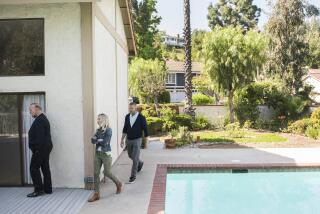Median home price falls in Southland
- Share via
The Southland’s housing market is flooded with cash-rich, bargain-hunting investors snapping up distressed homes and dragging down overall prices — but their presence also indicates the market could be nearing bottom.
At $260,000, the region’s median home price was only 5.2% above the low hit during the worst of the recession in 2009, according to San Diego research firm DataQuick. January brought a 3.7% decline in the median price, the point at which half the homes sold for more and half for less, compared with both a month earlier and a year earlier.
Foreclosures, tight mortgage credit and high regional unemployment remain significant impediments to a housing recovery, though experts warn that January is not indicative of how the rest of the year will play out. Many observers expect the long-suffering housing market to finally hit bottom in 2012, particularly if the jobs picture brightens.
“While we are seeing year-to-year declines in home prices, I think we should probably see things level out as we get further into 2012,” said Robert Kleinhenz, chief economist with the Los Angeles County Economic Development Corp. “As we get further into the year we may see home prices stabilize.”
A separate report by Irvine data tracker RealtyTrac showed progress on foreclosures last month, with California filings hitting a 50-month low, as fewer new foreclosure actions were filed last month.
A total of 51,584 foreclosure filings were made against California properties in January — from the default notice that begins the foreclosure process to the auction scheduling to sale of the house — a 23% decline compared with January 2011. California posted the nation’s second-highest foreclosure rate, after Nevada, and nine out of the 10 hardest hit cities were in the state.
Experts warned that the Golden State could see more troubled properties hitting the market now that a settlement over foreclosure abuses has been reached among state attorneys general and the nation’s five biggest mortgage banks.
The declines in December and January were broad-based and most likely due to banks slowing down on foreclosures during the holidays and in anticipation of a mortgage settlement with the government, said Daren Blomquist, an analyst for RealtyTrac.
Nationally, foreclosure filings increased 3% from December but were down 19% from January 2011.
The housing report by DataQuick, released Wednesday, highlighted two trends playing out in Southern California: Sales of new homes hit their lowest tally on record in January, while so-called absentee buyers — mostly investors as well as some second-home buyers — made up a record share of the market.
Short sales, in which a bank allows a home to be sold for less than what’s owed on the property, also hit a recent high last month.
Builders have trouble peddling new homes against the competition from cheap, distressed properties.
Richard Green, director of the USC Lusk Center for Real Estate, said that so much investor activity is encouraging, “but it also explains why prices are so depressed because you have these investors who can buy lots of homes with cash, and they are able to buy at a discount because the sellers want to get rid of stuff and they don’t want to worry about whether a buyer has financing.”
Southern California sales were up 0.4% last month from January 2011. A total of 14,523 newly built and previously owned single-family homes, town homes and condominiums changed hands last month, down 24.5% from December, though such a decline from December to January is seasonal in nature and common.
The market for new homes remained especially weak in January, with only 669 newly built properties selling in the region last month, the lowest number for any month since DataQuick started keeping track in 1988.
The sales data indicated that prospective buyers are still finding it difficult to get financing for their homes, and therefore cash has been a significant factor driving sales, DataQuick President John Walsh said.
“What we can determine is that the mortgage market remains dysfunctional,” Walsh said.
Underscoring that trend, the number of government-insured Federal Housing Administration loans declined last month to make up 31.2% of all purchase mortgages in January, down from 33.2% in January 2011. That is an indication that first-time buyers could be losing market share.
In a speech before members of the National Assn. of Home Builders in Orlando, Fla., last week, Federal Reserve ChairmanBen S. Bernanke said lending standards among the nation’s largest financial institutions remained too tight.
“Potential first-time home buyers have been disproportionately affected by the very tight conditions in mortgage markets,” Bernanke said. “Lending to potential first-time home buyers has dropped precipitously, even in parts of the country where unemployment rates and housing conditions are better than the national average.”
Southern California’s median sales price of $260,000 was the lowest since the $249,000 reached in May 2009, during the depths of the financial crisis, and only slightly above the low of $247,000 that was set in April 2009.
Driving the continued poor performance in prices is a concentration of properties being purchased in cheaper markets by investors. Absentee buyers bought a record 26.8% of Southland homes in January, paying a median price of $193,500.
In the Inland Empire, absentee buyers accounted for a record 33.6% of home sales.
So-called distressed sales continued to make up more than half the market for previously owned homes. Foreclosures made up 32.6% of the market last year, down from 36.8% in January 2011. The region has experienced a significant increase in short sales over the last year, and last month the transactions made up a record high of 21.3% of the market, an increase from 19.6% in January 2011.
More to Read
Inside the business of entertainment
The Wide Shot brings you news, analysis and insights on everything from streaming wars to production — and what it all means for the future.
You may occasionally receive promotional content from the Los Angeles Times.









